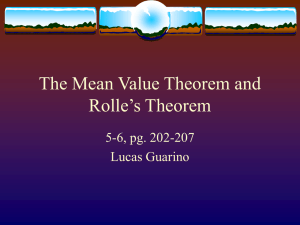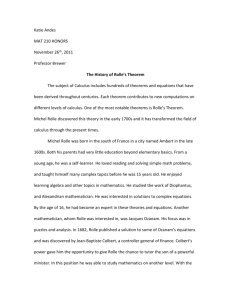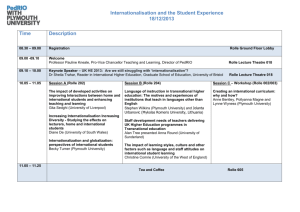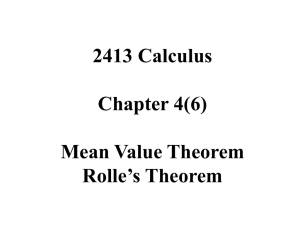McIlroy. Only the lonely the solitary life in Richard Rolles The Form
advertisement
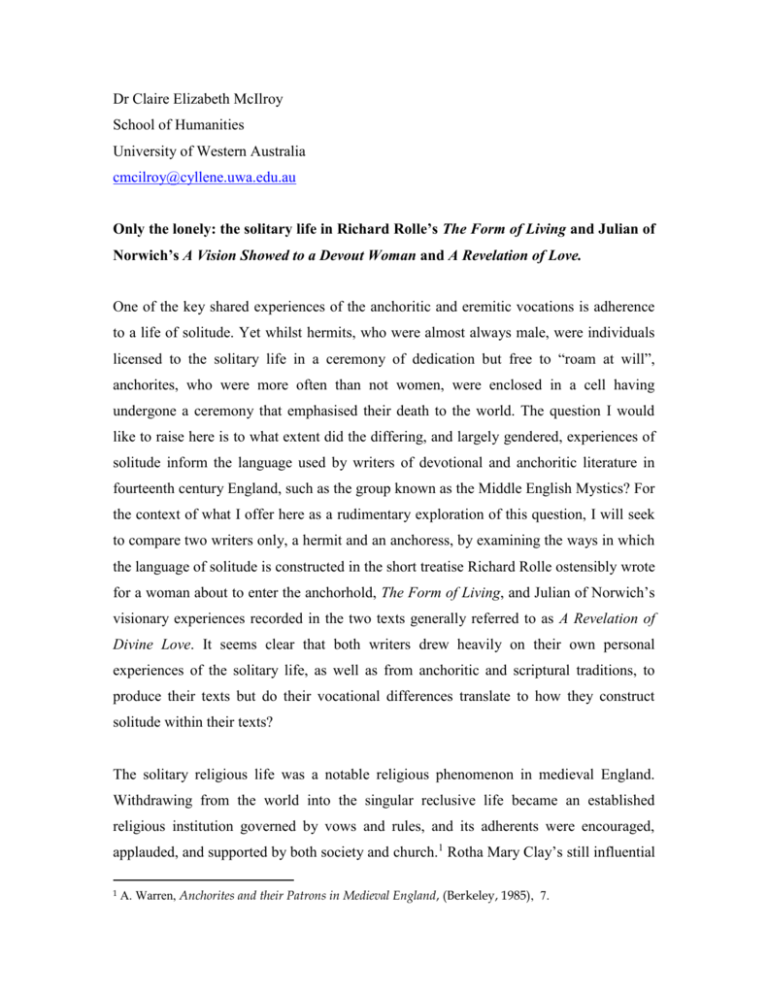
Dr Claire Elizabeth McIlroy School of Humanities University of Western Australia cmcilroy@cyllene.uwa.edu.au Only the lonely: the solitary life in Richard Rolle’s The Form of Living and Julian of Norwich’s A Vision Showed to a Devout Woman and A Revelation of Love. One of the key shared experiences of the anchoritic and eremitic vocations is adherence to a life of solitude. Yet whilst hermits, who were almost always male, were individuals licensed to the solitary life in a ceremony of dedication but free to “roam at will”, anchorites, who were more often than not women, were enclosed in a cell having undergone a ceremony that emphasised their death to the world. The question I would like to raise here is to what extent did the differing, and largely gendered, experiences of solitude inform the language used by writers of devotional and anchoritic literature in fourteenth century England, such as the group known as the Middle English Mystics? For the context of what I offer here as a rudimentary exploration of this question, I will seek to compare two writers only, a hermit and an anchoress, by examining the ways in which the language of solitude is constructed in the short treatise Richard Rolle ostensibly wrote for a woman about to enter the anchorhold, The Form of Living, and Julian of Norwich’s visionary experiences recorded in the two texts generally referred to as A Revelation of Divine Love. It seems clear that both writers drew heavily on their own personal experiences of the solitary life, as well as from anchoritic and scriptural traditions, to produce their texts but do their vocational differences translate to how they construct solitude within their texts? The solitary religious life was a notable religious phenomenon in medieval England. Withdrawing from the world into the singular reclusive life became an established religious institution governed by vows and rules, and its adherents were encouraged, applauded, and supported by both society and church.1 Rotha Mary Clay’s still influential 1 A. Warren, Anchorites and their Patrons in Medieval England, (Berkeley, 1985), 7. work on the hermits and anchorites of medieval England documents some 650 solitaries active from the twelfth through to the early sixteenth century and also records significant evidence to suggest a constancy of patronage for solitaries from all levels of society throughout this period.2 Indeed, by the fourteenth century hermits and anchorites were widespread in England and significant texts on both the anchoritic life and the contemplative life in general had already been produced. Examining the social significance of the eremitic movement in fourteenth- and fifteenth-century York, Jonathan Hughes discovered that throughout the fourteenth century recluses were prominent as counsellors of the laity, providing personal spiritual guidance to all levels of society. Their operations increased lay participation in the contemplative life, especially when they provided vernacular contemplative literature.3 Both Rolle and Julian were thus able to both continue and expand this textual tradition in what Nicholas Watson has described as “a nation-wide explosion of vernacular theology”4 According to the Latin vita that outlines Richard Rolle’s early life he was a young man in a hurry to become a practising solitary.5 Having fled what he considered the worldly horrors of university life at Oxford he returned home to Yorkshire where the wife of a wealthy landowner agreed to provide him with his first reclusive abode in her house. From this early domestic cell we know that Rolle moved several times before settling at the priory in Hampole in North Yorkshire where he lived until his death in 1349. His life was dedicated to producing a vast body of work in both Latin and English in which the solitary life is one of the central concerns. He was also somewhat of an eremitic renegade and writes of his frequent clashes with local clergymen who disapproved of the zealous See R. M. Clay, The Hermits and Anchorites of England, (London, 1914). See J. Hughes, Pastors and Visionaries: Religion and Secular Life in Late-Medieval Yorkshire, (Woodbridge, 1988), esp. 77-78 and 109-126. 4 N. Watson, “Julian of Norwich” in The Cambridge Companion to Medieval Women’s Writing, eds. Carolyn Dinshaw and David Wallace, (Cambridge, 2003), 221. 5 See R. M. Woolley, The Officium et Miracula of Richard Rolle of Hampole, (London, 1919). The Officium details Rolle’s life from his birth “in uilla de Thornton Eboracensis diocesis” to his death at Hampole in 1349. Composed as nine lessons the document describes significant episodes in Rolle’s life such as his placement at Oxford under the patronage of Thomas Neville, Archdeacon of Durham, his return to Yorkshire and conversion to the eremitic life, his accommodation by wealthy gentry patrons such as the Dalton family, and his lifelong spiritual trials and tribulations. It also provides details of miraculous events which were reported to have occurred both during his lifetime and at the site of his tomb. 2 3 and unorthodox ways of the self-styled hermit. In one text he is even forced to invoke the early Church eremites as a precedent when he is criticised for apparently not maintaining a fixed abode.6 Yet despite these personal difficulties, throughout his corpus Rolle insists that the solitary has a much greater chance of becoming one of the perfecti and he argues on a number of occasions for the superiority of the eremitic life, especially since its material conditions, unlike fourteenth-century monastic life, allow for the experience to emerge in the self.7 For medieval contemporaries at least Rolle’s reputation as a holy hermit authorised the man far more than his writings. In most manuscripts the surname Rolle is absent and he is referred to as simply “Richard the Hermit”. When Rolle came to write the English treatises, in the latter part of his life, he combined two long standing religious traditions: that of biblical exegesis, which he practised in both Latin and English; and that of liturgy, both as a source for some of his imagery, and as model for the arrangement of the different voices present in the treatises. The Form of Living is also replete with devotional material for the spiritual well being of solitaries and therefore participates in the anchoritic tradition of Ancrene Wisse and the “Wooing Group”.8 This is a tradition which also derives largely from the Song of Songs and its commentary tradition for the most affective sections. Together, these three traditions not only allow Rolle to position himself as a sophisticated spiritual adviser, they also appear to influence him to consider a particular strategy which draws on the Song of Songs tradition while addressing a primary audience of those who are about to enter, or already belong to, the solitary life as advocated by the anchoritic tradition.9 Rolle’s last known work, the Form of Living, is a short hortatory work ostensibly written for a female religious about to enter an anchorite’s cell. I have argued at length elsewhere R. Rolle, The Fire of Love, trans. Richard Misyn. E.E.T.S. (London, 1896), 35: 22-25. D. Renevey, Language, Self and Love: Hermeneutics in the Writings of Richard Rolle and the Commentaries of the Song of Songs, (Cardiff, 2001), 109. 8 See fie Wohunge of Ure Lauerde, ed. W. M. Thompson, (London, 1958); Old English Homilies, ed. R. Morris, (London, 1868); Middle English Religious Prose, ed. N. F. Blake, (London, 1972). 9 D. Renevey, The Moving of the Soul: The Functions of Metaphors of Love in the Writings of Richard Rolle and Antecedent Texts of the Medieval Mystical Tradition, (Oxford University, 1993). 189. See also S. S. Hussey, “The Audience for the Middle English Mystics”, De Cella in Seculum: Religious and Secular Life and Devotion in Late Medieval England. Ed. M. G. Sargent, (Cambridge, 1989), 109110. 6 7 that it is effectively a more generic treatise that seeks to guide the reader towards an understanding of the solitary life through a discourse of Christian friendship.10 It was widely read and disseminated in the later medieval period as a text in it’s own right and is also found in a number of pious manuscript compilations and early printed works of a devotional nature which circulated amongst the laity, such as the fourteenth-century English manual of popular religious instruction known as The Pore Caitif,11 the popular Latin mystical compilation Speculum Spiritualium,12 and the theological compendium Speculum Christiani.13 A text devoted to the practice of solitary living, it would seem, was equally able to provide spiritual guidance to the wider community as it was to the smaller group of adherents within reclusive vocations. Within the text, as Denis Renevey suggests, the solitary life stands as a model of perfection, with far-reaching implications, touching upon social, spiritual and linguistic dimensions, and shaping the relationship between Rolle and his recipient. 14 Yet the early part of work is interesting in the way it lurches between being an exuberant celebration of the solitary life and a litany of anxieties associated with achieving a successful reclusive vocation. Initially, Rolle warmly affirms the joys of the solitary life by telling the reader: In a few years thou shalt haue more delite to be by thyn on and spek to thi loue and thi spouse Ihesu, than if thou were lady of a thousand worldes.15 (6/128-130) See C. McIlroy, The English Prose Treatises of Richard Rolle, (Woodbridge, 2004). See M. T. Brady, “Rolle and the Pattern of Tracts in The Pore Caitif”. Traditio 39 (1983), 456465 and “Rolle’s Form of Living and The Pore Caitif”. Traditio 36 (1980), 426-435. 12 Speculum Spiritualium. Syon Monastery MS M. 118, fol. xxxvii v cited in H. E. Allen, Writings 10 11 Ascribed, 263 and 405-406. 13 Speculum Christiani is a translation of a widely circulated Latin-English pastoral manual compiled in the late fourteenth century for the use of the clergy. See A Manual of the Writings in Middle English, vol. 7, 2265. See also V. Gillespie, “The Evolution of the Speculum Christiani”. Latin and Vernacular: Studies in Late-Medieval Texts and Manuscripts. Ed. A. J. Minnis, (Cambridge, 1989), 39-62. 14 D. Renevey, Language, Self and Love, 142. 15 S. Ogilvie-Thomson, Richard Rolle: Prose and Verse, (Oxford, 1988), 6. Hereafter, all page-andline parenthetical references to The Form of Living are to Ogilvie-Thomson’s edition. He is also keen to assert the joys of his own reclusive vocation by representing himself and the reader standing, as it were, together in a mutual understanding of the joys of solitary life against the misunderstanding of the rest of the world: Men weneth that we haue peyn and penaunce, bot we haue more ioy and verrey delite in oon day than thei haue in the world al har lyfe. (6/130-132) And then he pronounces his signature resolution that the practice of solitude is more likely than just about anything else to lead to spiritual perfection: The state that thou art in, that is solitude, that is most able of al othre to reuelaciouns of the Holy Goste. (6/138-139) Yet following this he then almost systematically warns the reader also that solitude brings about its own trials and tribulations, suggesting that the nature of interiority is to be questioned at all times. The solitary life is certainly praiseworthy (6/122-150) but the emphasis on sin and temptation is maintained by Rolle’s specially considering the devil’s wiles against those who are solitary (7/161-181, 8/203-232). He is careful to stress that solitude is as much about physical and mental endurance as it is about a state of spiritual being by asserting that: No man cometh to such reuelaciouns and grace the first day, bot throgh longe trauaille and bisynesse to loue Ihesu Criste, as thou shalt hire aftreward. (6/148-149) Trials are a condition of perfection, Rolle warns, and “the greuouser thei stonden agayne and ouercomen, the moor shal har ioye be in his loue whan thei ben passed” (7/152-154). Perhaps to draw the reader towards an acceptance of the solitary life, Rolle again amplifies the negative aspects of solitude in order to then endorse the vocation. He warns that the devil actively “tempteth men and wommen that ben solitarie, bi ham on” (7/161) because being alone, they are vulnerable to his suggestion. To amplify the point, he invites the reader to identify with the example of another recluse “that was a good womman” who is tempted by a vision of the devil in the guise of a good angel but whom she proves to be a false image after taking the advice of her “shrift-fadyre” and calling “Aue Maria”, causing the apparition to disappear.16 The solitary must be ever vigilant and constantly look within themselves, the interiority necessary to their vocation, in order to overcome temptation. He also seems at pains to establish his own solitudinous state as inward, passive and unmoving by referring to himself sitting, and to the joy of his own spiritual rest, a number of times in The Form of Living. This quasi-domestic, and in many ways female, image is closely linked with both Rolle’s identification in The Form of Living of his authorial self and the reader as the eternal bride of Christ and his own selfassociation with the common medieval representation of the figure of male philosopher, sitting alone in his study in order to pursue enlightenment.17 The affirming yet warning language Rolle uses in the Form of Living suggests that from his hermit’s viewpoint the solitary life is hard won. In turn, the articulation of interiority found throughout the work, the continual appeal to the reader to “sek inwardly” as he so expressively puts it in the Commandment, and to “thynke” Rolle’s words in the heart, further speaks for the importance of empowering the individual within Rolle’s religious discourse on the solitary life. The language he uses has a two fold effect: it not only exemplifies his own experience as a solitary as a point of reference but it draws the reader closer to experiencing a kind of solitude of thought, even if they cannot aspire to the heights of an actual solitary existence. Throughout the Form of Living the subtle inference appears to be that Rolle knows that he himself requires solitude not only to Rolle claims that he relays the story from a single textual source, “as I fynd of a recluse written” (7/166) but the passage itself bears close resemblance to a passage from Cassian’s Collations, and the idea of Satan changing himself into an angel of light comes from 2 Corinthians 11:14 (“ipse enim Satanas transfigurat se in angelum lucis”), which is exactly how it appears in Collations. 16 In The Form of Living, as in Cassian, the devil transfigures himself into an angel of light “and so he deceyueth foles. Bot ham that ben wise, and wol nat anoon trow to al spirites, bot asketh consaille of conynge men, he may nat begile ham” (7/164-166). 17 Both Augustine and Jerome have a long iconographic history which depicts them sitting alone in the study surrounded by books. For an extensive coverage of iconographic representations of Jerome see E. F. Rice, St. Jerome in the Renaissance, (Baltimore and London, 1985). 16 become one of the perfecti himself but also to allow him to guide others in the journey towards spiritual perfection he believed “euery sinful man and woman” should aspire to. For the anchoress Julian of Norwich the solitary life would appear to be another matter altogether. Of the scant amount we know about Julian’s life the one thing we know for certain is that after 1393 she became an enclosed anchoress in Norwich, one of the busiest urban centres in fourteenth-century England. Julian’s two known texts, A Vision Showed to a Devout Woman and A Revelation of Love, recount the same visionary episode she experienced in her thirtieth year, when she was either a laywoman or a nun, following a period of near-fatal illness. Similarly to Rolle, Julian’s contemporaries directly associated her writings with her vocation and in the few remaining manuscript copies of her works she is described in Middle English as “Julyan that ys recluse atte Norwynche” and in Latin as “Juliane anacorite Norwiche”. Julian is also named in a number of wills and bequests and is mentioned in the book by her contemporary visionary Margery Kempe. Kempe, who lived in nearby Lynn, specifically sort out Julian in her capacity as a spiritual guide and her description of their meeting is striking for the heavy emphasis Kempe places on directly identifying Julian by her anchoritic vocation: And than sche was bodyn be owyr Lord for to gon to an ankres in the same cyté whych hyte Dame Jelyan . . . and many wondirful revelacyons whech sche schewyd to the ankres to wetyn yf ther wer any deceyte in hem, for the ankres was expert in swech thyngys and good cownsel cowd gevyn. The ankres, heryng the mervelyows goodnes of owyr Lord, hyly thankyd God wyth al hir hert for hys visitacyon. . . Mych was the holy dalyawns that the ancres and this creatur hadden be comownyng in the lofe of owyr Lord Jhesu Crist many days that thei were togedyr18 Julian’s anchoritic status, it would seem, not only renders her an “expert” in matters visionary but also allows the “good cownsel” that is fully expected of her to authorise Kempe’s own visionary experiences. In Julian’s earlier work, A Vision Showed to a Devout Woman, she outlines the background to her visionary experience and, more importantly, something of the nature 18The Book of Margery Kempe. Ed. Lynn Staley (Kalamazoo, 1996), 19 (lines 955-988). Italics mine. of her pre-visionary aspirations and priorities.19 She tells us that she “desirede thre graces be the gifte of God” which are “to have minde of Christes passion”, “bodelye sykenes” and then “the third was to have of Goddes gifte thre woundes” (Vision, 1/1-3). It is the second gift of “bodily sekenesse . . . so harde as to the dede” that I would like to focus on here as I believe it underpins Julian’s experience of the solitary life as a means to achieving the personal relationship with Christ that is central to her visionary experience. Modern psychologists might be tempted to associate Julian’s prayed for period of illness with what is often referred to as “creative malady”, a state of being where an individual’s creative endeavour can only be achieved following a severe psychosomatic crisis. 20 It could certainly be argued that throughout the history of Christian mysticism many individuals have experienced such episodes. But I am not sure that this is the case for Julian and what I would like to argue instead is that what the illness really permits Julian is a pre-anchoritic state of solitude. Where, enclosed in her almost expired earthly body, she can experience the veritable, living removal from the world that appears to be necessary for her to receive her visions. The passages in A Vision that refer specifically to the illness are replete with references to a self-directed withdrawal from the bodily world. “I wenande myselfe” Julian tells her reader “that I shulde die . . . For I wolde hafe no comforth of no fleshlye nothre erthelye life” (Vision, 1/23-25). 21 She also informs her reader that “This sekenes desirede I in my youth, that I might have it whene I were in threttye yeere elde” (Vision, 1/34-35) giving the impression that she had longed to achieve this spiritual withdrawal from the world since childhood. When the sickness does come the language she uses to express the experience of bodily dying is a vivid mixture of fear, she is “right sarye and lothe thought for to die” (Vision, 2/6), and desire to assent to “Goddes wille” (Vision, 2/15) that she will indeed die. And although she tells us that she has already taken “alle my rightinges of haly kyrke” (Vision, 2/3), when it is first thought that she is dying, it is when the parish 19 20 C. Abbott, Julian of Norwich: Autobiography and Theology, (Woodbridge, 1999), 47. See also Showings: Julian of Norwich. Eds Edmund Colledge and James Walsh, (New York, 1978), 5. The Writings of Julian of Norwich: A Vision Showed to a Devout Woman and A Revelation of Love. Eds. Nicholas Watson and Jacqueline Jenkins, (Pennsylvannia, 2006), 66. Hereafter, all section or chapter and line parenthetical references to Julian’s works are from this text. 21 priest arrives for the second time to ease her passing from the world by providing an “image of thy savioure” (Vision, 2/23) for her to focus her last gaze upon that the preanchoritic state begins. The reception of the last rites here is arguably analogus to the ceremony of enclosure she will undergo later in life when she is professed as an anchoress. Enclosed in her non-functioning earthly body her sight begins to fail and using imagery that could be viewed as prefiguring her future anchoritic cell she tells us that “it was all dyrke aboute me in the chaumber, and mirke as it hadde bene night” (Vision, 2/29) save for a natural light emitting from the area of the crucifix. The obvious comparison here being the view to the altar the anchoress has through her squint window post enclosure. Engulfed in this semi-darkness Julian “sodeynlye”, a recurrent word in this part of the text implying the direct intervention of God, feels better but is still fully expecting to be soon “deliverede of this worlde” (Vision, 2/40-41). Thus, with the deathbed enclosure narrative complete, the newly anchored Julian, dying but still alive in her “dedlye bodye”, “sodeynlye” receives the long prayed for visions. And although Julian edits much of the deathbed scene in her text A Revelation of Love, cutting references to both the child (acolyte) who accompanies the priest and her own mother, the powerful narrative of her near-death experience remains intact. In fact, the less personal and more methodical presentation of the scene in the opening of A Revelation somehow more appropriately reproduces the precise utterings one might expect from a professed anchoress. As Nicholas Watson has pointed out, the later text opens not with the cautious “Here is a vision” of the earlier work but with the explosive “This is a revelacion of love”, implying that a resolute exposition is to follow.22 Secure in her anchoritic state Julian is able to validate enclosure as a place to produce such a text and thereby validates her own choice of a life of enclosure and the text that is the product of her enclosure.23 In turn, she does not then need to focus on the practice of solitary living in the same way that a hermit might who has to guard against the perception that his life of solitude is rather more precariously placed. Julian would also have been well aware that the solitude anchoritic guides such as Ancrene Wisse ascribes is metaphoric, N. Watson, “Julian of Norwich”. The Cambridge Companion to Medieval Womern’s Writing. Eds. Carolyn Dinshaw and David Wallace, (Cambridge, 2003), 213. 23 Krantz (p.3) 22 rather than physical, especially given the busy situation of her cell, but the fact of her enclosure ensures her solitary reputation. Once Julian is anchored in the enclosed world of her visions, which is also paradoxically an opening up of experience for her, the nature of her existence, solitary or otherwise, is no longer required for discussion. Following the exposition of the reception of the visions both A Vision and A Revelation of Love focus on a series of visual showings that centre upon Christ's suffering during the crucifixion intermingled with discussions of secular images, such as the famed hazel nut cosmos, and reflections on the nature of certain aspects of Christian spirituality. Of her solitary life or the anchoritic vocation itself there is barely another word save for one small reference to the dangers of pridefully setting oneself apart from others: For if I loke singulerlye to myselfe, I am right nought. Botte in generalle, I am in anehade of charite with alle myne evenchristende. (Vision, 6/19-20) The vice of singularity is one that any practising visionary would be warned against and one that Rolle also alludes to in the Form of Living as numbering among the temptations sent by the devil I mentioned above.24 Both Julian and Rolle are acutely aware that their adherence to the solitary life is the gateway to spiritual perfection in this world, but there are certainly ample differences in their approach. Most notably, Rolle the hermit seems more preoccupied with his audience’s awareness of both the rewards and the anxieties associated with the solitary life. Whereas the enclosed Julian has a limited amount to say on the solitary nature of the anchoritic vocation both regarding her own experience and that of her audience. For Julian the experience of the solitary life is not something that needs to be articulated, both her illness and the subsequent anchoritic life she chooses simply are solitary. For Rolle the life of a hermit is about accepting, practising and carefully managing solitude and, in the Form of Living at least, about making sure those who wish to follow this path are fully informed of the difficulties associated with the vocation. 24 See The Writings of Julian of Norwich. Eds. Nicholas Watson and Jacqueline Jenkins, 72. From this brief exploration, then, of Rolle and Julian’s varied discourse on solitary living we can begin to see that one key difference between the two at least is that the perception the solitary life is of far more concern to the hermit than it is to the anchoress. A life lived in solitude, it would seem, was not always, for the hermit, the avowedly self-occupied experience that it was for the enclosed anchorite. What also seems apparent, however, is that the practice of the solitary life is essential to both writers in their own personal spiritual journeys and is therefore in many ways fundamental to the production of both their discourses about this journey.
